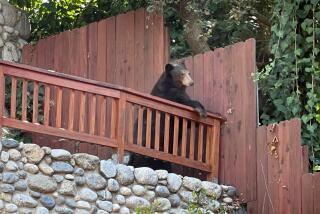Brown Bears Eternally Playful, Say Researchers
- Share via
PACK CREEK, Alaska — A husband and wife who study brown bears in the Alaska wilderness believe the huge carnivores are among a small group of intelligent animals that are playful all their lives.
Brown bears play games with each other and appear captivated by tree limbs, stumps, stones and tall grass. Their high jinks don’t stop as they grow from cubs into adults, says Bob Fagen, an animal behavior specialist and associate professor of biometry at the University of Alaska.
“It looks like the brown bears of Pack Creek may be one of the rare species that play the same amount through all of their lives,” Fagen said.
That puts them in the company of chimpanzees, lions, wolves and several domestic animals, those Fagen calls “a small select group of intelligent, social, cultural species.”
“The bears stand out because they don’t have a very cooperative relationship, like wolves,” he said.
Brown bears are reputed loners. At Pack Creek they chase each other, snap and trade growls. Sometimes the growling turns into fighting.
Fagen has spent four summers at Pack Creek, 30 miles south of Juneau on Admiralty Island, to observe about 30 bears that gather to catch spawning salmon. His wife, Johanna, a biologist, has spent three summers there.
In July and August, the Fagens live in a tent on an island off the creek mouth with their 8-year-old son, Kevin, and a rotation of graduate students who help keep track of the bears. They monitor bears 12 to 15 hours a day from a tree stand, a tarpaulin-covered platform about 15 feet above ground.
Interactions With People
In addition to their studies of play, the Fagens monitor all the bears’ movements and interactions with people.
The records help wildlife officials determine how bears are affected by the crowds of people who show up every summer to photograph them. Bears disturbed by clicking shutters, overflying aircraft or other activity show changes in their behavior.
“The most sensitive indicator we know is play,” Fagen said. “Play tends to be inhibited by any kind of stressful or strange experience.”
Though one researcher at Pack Creek thought the bears’ play was inhibited when people were around, the Fagens say they have not found the same result.
Johanna Fagen has watched cubs playing chasing games, and she saw an older bear lie on its back and roll a huge, rotted stump atop its upended paws. “They are very oriented to objects. They like to push and pull stones. They play-fight with a clump of grass or an overhanging branch.”
The Fagens saw an adult male and female sliding down a patch of snow, apparently in fun, during the mating season.
Mrs. Fagen also suspects that bears indulge in pleasures humans might not recognize as such: rolling in dead fish, for instance. She said the bears seem to appreciate smell, being attracted to fish and gasoline and fond of rolling in a sawdust pile.
More to Read
Sign up for Essential California
The most important California stories and recommendations in your inbox every morning.
You may occasionally receive promotional content from the Los Angeles Times.













